![]()
Antique Paperweights for Sale
![]()
Antique Paperweights for Sale
| 1603 | Antique Franchini Type Aventurine Venetian
Murine Paperweight Scent Bottle. circa 1840-1880.
This rare Franchini type miniature Venetian scent bottle has two
early murrine canes. On the front is a murrine of a
gondola. The murrine on the back depicts a winged lion on
water, or the Lion of St. Mark. This murrine has a small
fracture in the cane. The six-sided shape is similar to known
scent bottles made by Giacomo Franchini. The glass is filled
with aventurine and colored swirls. It is in very good
condition aside from the fractured murrine and has normal age
appropriate wear. There are also small fractures on the
neck. It does not have its original stopper and hinged
cap. Most likely it also originally had a chain. Despite
the similarity to known Franchini items, I am selling this as
"Franchini Type" as other glass artisans of the period probably
copied the work of the Franchini workshop. For comparable images, see the following pages in Miniature Masterpieces - Mosaic Glass 1838-1924 by Giovanni Sarpellon. A similar six-sided scent bottle appears in figure 520 on page 57. Similar gondola murrine appear in figures 425-439 on page 47. The lion of St. Mark appears in figure 422 on page 46. Note on condition: The scent bottle has several flaws. The cane of the Lion of St. Mark has a small fracture. There are also small fractures on the neck. The scent bottle does not have its original stopper, hinged cap, or chain. It also has age appropriate wear. Giacomo (Jacopo) Franchini (1827-1897) worked with his father Giovanni Battista Franchini (1804-1873) on the development of millefiori canes incorporating figurative designs as well as floral patterns. His is best known for his miniature portraits of the famous people of his time. He produced some of the most remarkable glass portraits and many were incorporated into scent bottles, walking stick handles and other objects, some useful and some purely decorative. His creative period ended in 1863 when he was confined to an asylum. For more details on the remarkable work produced by the Franchini family and others of the period, see the book Miniature Masterpieces - Mosaic Glass 1838-1924 by Giovanni Sarpellon. Miniature size: Just over
2 3/8" tall by just under 15/16" wide by 11/16" thick..
It weighs two ounces. The base is ground flat. For extra pictures, click on the picture at the right and the following links: Large picture$395 postage paid in the US. Click on the picture to see a larger image. |
Click
on the picture to see a larger image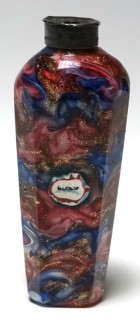 |
| 2048 | Magnum Antique Graeser Order of Elks
Paperweight. circa 1890. This uniquely American
style paperweight features a detailed image of an elk with very
large antlers above the logo "B.P.O.E." logo for the "Benevolent and
Protective Order of Elks". On each side of the elk are two
colorful hand painted floral sprays, each with a large light pink or
amber rose. There is a clock pointing to the 11 o'clock hour
in the center below the elk. The elk and hand painted spray
are placed on a white enamel disk. The image at the center was
printed onto the white disk using a photographic process developed
by William Maxwell and commercialized by Albert Graeser. After
the decorations were complete the disk was encased in glass.
The hand painted floral sprays and large roses are
outstanding. A wonderful paperweight. Note on colors: The pictures don't capture the color accurately. The roses are a light pink or amber with a slightly yellow tint. Albert Graeser was a well known producer of photographic paperweights working in Pittsburgh, Pennsylvania in the 1890-1900 period. He used a process patented by William H. Maxwell in 1882. For more information on this style of paperweight see the article "Fraternally Yours" by William Price, Jr. in the 2001 Annual Bulletin of the Paperweight Collectors Association. This style of paperweight is also described on page 413 of American Glass by George and Helen McKearin. Very large size: 3 3/8" diameter by just over 2 3/8"
high. The base is ground flat and finished with a matte
finish although there is a remnant of the pontil mark. For extra pictures, click on the picture at the right and the following links: Large picture$145 postage paid in the US. Click on the picture to see a larger image. |
Click
on the picture to see a larger image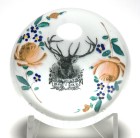
|
| 1497 | Antique New England Glass Company (NEGC)
Rare Spoke Design Millefiori Paperweight. circa
1860-1888. Interesting NEGC paperweight with an
unusual / rare millefiori spoke pattern. The design has some
unusual millefiori canes. Great collectors item. Note about condition: Good to very good condition. The paperweight has a very low profile and the millefiori canes are high in the design. This paperweight was probably refinished by a previous owner to remove damage. Wear on the base and near the base was left untouched. There is also one faint remnant of a circular impact mark near the base. The New England Glass Company (NEGC) operated in Cambridge, Massachusetts from 1818 to 1888. You can read about paperweights from the New England Glass Company in the book by John Hawley. The Art of the Paperweight - The Boston & Sandwich and New England Glass Companies covers both B&S and NEGC. Small size: 2 1/4" diameter by 1 1/8" high.
Low profile. The base is ground concave. For extra pictures, click on the picture at the right and the following links: Large pictureSOLD.
Click on the picture to see a larger image. |
Click
on the picture to see a larger image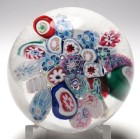 |
| 3506 | Antique Baccarat Miniature Single Clematis
with Millefiori Garland Paperweight. circa
1845-1860. Antique Baccarat miniature red/orange single
clematis with six ribbed petals, five leaves, and a stem. The
center of the flower is a complex millefiori cane with two rings of
white star shaped canes arranged around a red bulls-eye cane.
The clematis is surrounded by an outer garland of alternating ten
white and ten blue and white complex millefiori canes. The
white canes in the garland match the cane at the center of the
clematis flower. The blue and white canes have a ring of
arrowhead canes around a Baccarat star cane. The design is
placed over a clear ground and finished with a Baccarat star cut on
the base. The paperweight is unsigned but I guarantee that
this is a genuine Baccarat millefiori paperweight from the classic
period 1845-1860. A unique addition to any collection of
miniature paperweights. Great color. Note: The flower is noticeably off-center in this paperweight. Note on white glare: Please ignore the white areas, they are glare from the lights. According to Paul Dunlop in Baccarat Paperweights: two centuries of beauty, the single clematis is much rarer than the double clematis. Miniature Size: 1 15/16" diameter by just under 1
7/16" high. The bottom is ground slightly concave and is
finished with a Baccarat star. For extra pictures, click on the picture at the right and the following links: Large picture of the paperweight$1,750 postage paid in the US. US sales only for this paperweight. Delivery will require a signature. Click on the picture to see a larger image. Baccarat was founded in 1776 in Alsace-Lorraine with the name of Verrerie de Sainte Anne. The original location was near the town of Baccarat. Today the firm is known as Compagnie des Cristalleries de Baccarat. Most collectors refer to three periods of Baccarat paperweight production.
Baccarat continued to make paperweights after the classic period (1845-1860), but little is known about the extent of the product line or who made the paperweights. It is known that by 1910, the offering in the catalog had dwindled to pansy paperweights, simple open concentric paperweights, and rock paperweights. Popular lore attributes 1920-1934 Baccarat paperweights to a Mr. Dupont, who supposedly was the last worker at Baccarat to know the secrets of paperweight making. These paperweights were sold at a Baccarat retail shop in Paris. No collector or scholar ever met Mr. Dupont although at least one visited the Baccarat factory and asked to meet with him. The weights stopped appearing in the shop in 1934. New research of the Baccarat archives has identified the actual maker as Joseph Boyé (1877-1948). He is recorded as the maker of millefiori canes and millefiori paperweights during this period (1920-1934). Very little is known about Mr. Boyé, but there is enough similarity in the millefiori canes to suggest that he had access to the original molds or some of the original millefiori canes from the classic period. He later trained another glassworker, Georges Brocard, to make open concentric paperweights in 1946. Armed with this knowledge, Brocard was influential in the revival of paperweight making at Baccarat in the 1950s. Another glassworker, Louis Idoux (1882-1941), is recorded as making the Baccarat pansy paperweights during the 1920-1934 period. You can read more about the Baccarat paperweights in the new book Baccarat Paperweights - two centuries of beauty by Paul Dunlop or one of the older books on paperweights in general, such as The Encyclopedia of Glass Paperweights by Paul Hollister or World Paperweights by Robert Hall. |
Click
on the picture to see a larger image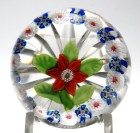 |
| 4747 | Antique Paperweight Style Mystery
Object - Probably a Cut Down Candle Holder. circa
1900. I don't know for sure what this was originally. It
is safe to assume the shape has been altered because it has no
apparent use in its current form except as paperweight. It has
a cup at one end and the other end is faceted with a flat
base. The middle section has a paperweight form with ice pick
flowers and small bubbles. The faceted end has a five sided
shape in the center with five sloping cuts away from that. I'm
certain it is an antique and that the cup end has not been
modified. The way the bubbles in the faceted end are towards
the center suggests that the cup was originally the up side.
I've discussed this with other collectors and our best guess is that
this was originally a candle holder for a fairly large candle which
would fit the cup. It is also likely that the original shape
was supported by a five sided stem and larger base to provide
stability. If you look at pictures of older style candle
holders or candlesticks you can find some with a round cup and
faceted stem. An interesting object - too good to throw in the
trash. I'm not asking much for it. Note: Although this object can be used in its current form as a candle holder, but caution you not to use it with a lighted candle. It doesn't have the large base that would normally provide the necessary stability. Size: In its current form, it is 3" long, the cup
has a diameter of 2". The inner diameter of the cup is just
over 1 1/2". The base is flat in the center. The
original shape is unknown. For extra pictures, click on the picture at the right and the following links: Large picture$65 postage paid in the US. Click on the picture to see a larger image. |
Click
on the picture to see a larger image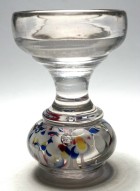 |
| 4388 | Large Antique Clichy Faceted Concentric
Millefiori Paperweight. circa 1845-1860. This
wonderful antique Clichy concentric millefiori paperweight has a
classic arrangement of three concentric rings of complex millefiori
around a blue pastry mold cane. The inner ring has nine Clichy
eight lobed edelweiss florets. The second ring consists of
fifteen purple eight lobed florets. The outer ring has an
alternating pattern of 24 pastry mold canes with six green pastry
mold canes and 18 pink pastry mold canes. In all, there are 49
millefiori canes over a clear ground. The canes are intricate
and very colorful. See the close-up picture for more
detail. There are six side facets and a top facet. A
fantastic paperweight.
Clichy paperweights are highly sought after by collectors for their complex canes and brilliant colors. Clichy paperweights with rose canes are especially desirable. The Clichy factory was founded at Billancourt near Paris in 1837. Shortly after that it moved to Clichy-la-Garenne, which gave the factory its best known name. They stayed in operation until about the 1870s. Large Size: 2 5/8" diameter by just under 1 3/4"
high. The base is ground concave. There are six side
facets and a large top facet. For extra pictures, click on the picture at the right and the following links: Large pictureNew Price $475 (was $950) postage paid in the US. Click on the picture to see a larger image. |
Click on the picture
to see a larger image 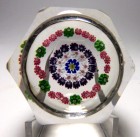 |
| 434 | Antique New England Glass Company (NEGC)
Five Ring Concentric Millefiori Paperweight. circa 1860
- 1888. This is an antique New England Glass Company (NEGC)
concentric millefiori paperweight with five rings of complex
millefiori around a larger complex millefiori center cane. The
design is placed over a clear ground. The rings are brown,
blue, pink, and white / green with a red cane in the
center. A great example of a NEGC concentric millefiori
paperweight. Note on execution: It is rare to find a NEGC millefiori design with a perfect execution. In this paperweight there is uneven spacing and imperfect circles, but no tipped canes and no cracked canes.
New England Glass Company (NEGC) operated in Cambridge, Massachusetts from 1818 to 1888. You can read about paperweights from the New England Glass Company in the book by Hawley, The Art of the Paperweight - The Boston & Sandwich and New England Glass Companies. Large Size: 2 5/8” diameter by 1 3/4" high.
The bottom is ground concave. There is the remnant of a
pontil scar on the base. For extra pictures, click on the picture at the right and the following links: Large picture$365 postage paid in the US. Click on the picture to see a larger image. |
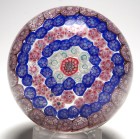 |
| 5382 | Antique New England Glass Company (NEGC)
Blown Glass Pear Paperweight - Good Condition. circa
1860. This is a wonderful antique New England Glass Company
(NEGC) life-size blown pear placed on a round clear glass
cookie. The pear is hollow. It is complete with blossom
end up in the air and an intact stem resting on the clear
cookie. The coloration shades from a light red to a
yellow-green. Unlike most examples of this type, there is no
crackling of the surface. The paperweight displays beautifully
with the sides or stem end displayed. Please read the note
below about condition. If you don't already have one in
your collection, this is a chance to acquire a NEGC blown pair at a
bargain price. Note on condition: Unfortunately there is an area near the blossom end that has a loss of surface color and a strange white stripe where no color was applied. There is some chipping near the blossom end. And there is also a tiny nick in the area of deep red where some color is lost. Finally, there is a fracture at the bottom of the pear visible only through the base. The most common NEGC blown fruit are apples and pears, although some collectors have seen other fruits. It is not unusual to find pieces of these fruit in scramble paperweights, mixed in with millefiori and twist canes. The shading of the colors on the exterior often leads to crackling and this flaw is found in varying degrees in many blown fruit paperweights. Normally a NEGC hollow blown pear paperweight would be a $800 to $1,000 paperweight but this one is offered at a considerably reduced price to compensate for the flaws in condition. The New England Glass Company (NEGC) operated
in Cambridge, Massachusetts from 1818 to 1888. You
can read about paperweights from the New England Glass Company
in the book by John Hawley. The Art of the
Paperweight - The Boston & Sandwich and New England
Glass Companies covers both B&S and NEGC or the newer
book by John Hawley devoted just to NEGC, The Art of the
Paperweight - The New England Glass Company. Size: The pear itself is 2 1/2” diameter by 3 1/4”
long. Overall dimensions are 3 7/16" diameter by 2 9/16"
high. For extra pictures, click on the picture at the right and the following links: Large picture$325 postage paid in the US. Click on the picture to see a larger image. |
Click
on the picture to see a larger image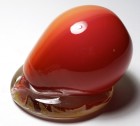 |
| 5378 | Antique New England Glass Company (NEGC)
Seal with Millefiori Nosegay Handle. circa 1860-1888.
Interesting NEGC seal with millefiori nosegay handle.
The nosegay has three marvelous complex millefiori. The base
has a grid cut and is not customized for the owner. Fair to
good condition, with many small chips on the edges and
corners. The handle has a six sided top facet plus two rows of
six facets each. The stem and base are six sided. Rare
item. The New England Glass Company (NEGC) operated in Cambridge, Massachusetts from 1818 to 1888. You can read about paperweights from the New England Glass Company in the book by John Hawley. The Art of the Paperweight - The Boston & Sandwich and New England Glass Companies covers both B&S and NEGC. Size: The six-sided handle is 1 5/16" wide at its
widest. 2 5/8" long. The base is 7/8" width at its
widest. Heavily faceted. For extra pictures, click on the picture at the right and the following links: Large picture$1,100 postage paid in the US. US Sales only, no international shipping. Delivery will require a signature.
Click on the picture to see a larger image. |
Click
on the picture to see a larger image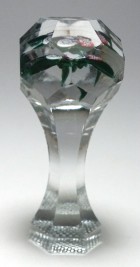 |
| 5102 | Large Antique Clichy Spaced Concentric
Millefiori Paperweight with 25 canes including a Green and Pink
Rose. circa 1845-1860. This wonderful antique
Clichy spaced millefiori paperweight contains an arrangement of 25
millefiori canes on lace ground. There are three rings with 12
canes in the outer ring, six in the middle ring and six in the inner
ring plus a wonderful large green and pink rose cane in the
center. The canes are intricate and very colorful. See
the close-up picture for more detail. A fantastic paperweight.
Clichy paperweights are highly sought after by collectors for their complex canes and brilliant colors. The Clichy factory was founded at Billancourt near Paris in 1837. Shortly after that it moved to Clichy-la-Garenne, which gave the factory its best known name. They stayed in operation until about the 1870s. Large Size: Just over 3 1/16" diameter by 2 1/8"
high. The base is ground concave. For extra pictures, click on the picture at the right and the following links: Large picture$1,295 postage paid in the US. US Sales only, no international shipping. Delivery will require a signature. Click on the picture to see a larger image. |
Click
on the picture to see a larger image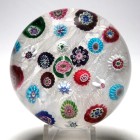 |
| 2270 |
German or Bohemian Souvenir
Paperweight with Ruby Stain Engraved Scene of Münster in
Freiburg. circa 1840-1910. This is
a large footed paperweight with an engraved image of the cathedral
of Freiburg im Breisgau in southwest Germany. There are
initials after the title which I assume are those of the engraver.
The engraving is done from the bottom which has a ruby
stain. The paperweight has a footed or pedestal base.
Size: 3 7/8" diameter by approximately 1 3/8" high.
The foot has a diameter of 3 1/2". For extra pictures, click on the picture at the right and the following links: Large picture$135 postage paid in the US. Click on the picture to see a larger image. |
Click
on the picture to see a larger image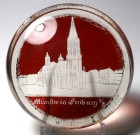 |
| 2100 | Large Antique New England Glass Company
(NEGC) Blue Double Poinsettia Paperweight on a Double Swirl
Latticinio Ground. circa 1860 - 1888. This is an
antique New England Glass Company (NEGC) double poinsettia with a
two rings of five dark blue petals arranged around an interesting
complex millefiori center. There are also three well formed
NEGC leaves and a stem. Well placed bubbles give the
appearance of dew drops on the flower and the leaves. The
design is placed over a double swirl latticinio ground. As is
typical of NEGC poinsettias, the flower is placed leaning off to the
left. This paperweight will be a worthwhile addition to
any collection of antique American paperweights offered at a bargain
price. Note on condition: Good to very good condition. There are some minor scratches on the body and considerable wear on the base. There is also a pontil scar on the base. No chips or impact marks. The center millefiori cane lacks proper coloration. The New England Glass Company (NEGC) operated in Cambridge, Massachusetts from 1818 to 1888. You can read about paperweights from the New England Glass Company in the book by John Hawley. The Art of the Paperweight - The Boston & Sandwich and New England Glass Companies covers both B&S and NEGC.
Large size: Just under 2 3/4" diameter by 2"
high. The base is ground concave. It has a relatively
high profile. For extra pictures, click on the picture at the right and the following links: Large pictureSOLD. Click on the picture to see a larger image. |
lick
on the picture to see a larger image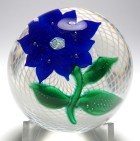 |
| 2254 | Antique Thuringia Lauscha Bohemia
Millefiori Paperweight with Name Plaque "Hauptm.
Karl". Circa 1870 - 1940. Colorful antique
paperweight with colorful millefiori canes arranged around a central
name plaque. The name "Hauptm. Karl" is probably an
abbreviation of "Hauptmann Karl", meaning Captain Karl or leader
Karl. The complex millefiori canes repeat in alternating
patterns to make up the design with 26 canes in all. The
pattern is arranged over a multicolored frit ground. There are
some wonderful complex canes in this paperweight. An
interesting example of a type of weight that is becoming more in
demand as collectors learn more about the various Bohemian factories
and eastern Germany factories. This is a relatively rare item.
The maker of this paperweight is unknown, except that it is believed to originate in the region along the Czech - German border, hence the label Bohemian. Similar paperweights have are on display in the museum in Lauscha and are identified as being from Lauscha in Thuringia. The area was part of Bohemia prior to WWI. Similar examples can be found in the book by von Brackel, Paperweights: Historicism - Art Nouveau - Art Deco - 1842 to Today See pages 90-95 and figure 507 on page 221. Large Size: 2 3/4" diameter by 1 11/16" high. The
base is ground flat with a matte finish. There is a
depression remaining from the pontil mark in the center. For extra pictures, click on the picture at the right and the following links: Large picture$195 postage paid in the US. Click on the picture to see a larger image. |
Click
on the picture to see a larger image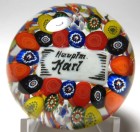 |
| 5385 | Large Antique New England Glass
Company (NEGC) Salmon Red Double Poinsettia Paperweight on a Blue
and White Jasper Ground. circa 1860 - 1888. This
is an antique New England Glass Company (NEGC) double poinsettia
with a two rings of five salmon red petals arranged around an
interesting complex millefiori center. Well place bubbles give
the appearance of dew drops. There are also three well formed
NEGC green leaves and a green stem. The design is placed over
wonderful blue and white jasper ground giving this paperweight a
patriotic red, white, and blue theme. Unlike many NEGC
poinsettias, the flower is fairly well centered. This
paperweight will be a worthwhile addition to any collection of
antique American paperweights. The New England Glass Company (NEGC) operated in Cambridge, Massachusetts from 1818 to 1888. You can read about paperweights from the New England Glass Company in the book by John Hawley. The Art of the Paperweight - The Boston & Sandwich and New England Glass Companies covers both B&S and NEGC.
Large Size: 2 11/16" diameter by1 5/8" high.
The base is ground concave. It has a relatively flat
profile. For extra pictures, click on the picture at the right and the following links: Large pictureSOLD. Click on the picture to see a larger image. |
Click
on the picture to see a larger image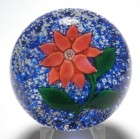 |
| 5699 | Large Antique Millville Umbrella
Paperweight. circa 1860-1912. This style
of old paperweight is associated with Millville, New Jersey.
Examples date from as early as 1860 and continued to be made until
about 1912. Many, if not all, were made at the Whitall Tatum
factory in Millville. The design consists of a white mushroom
shape with a center bubble. Additional colored bits of glass
are added and melted into the top. The top is of the mushroom
is pushed down with a crimp to form an umbrella shape with ribs or
pleats. The design is placed over a white frit ground.
This paperweight has minor flaws including surface scratches and an
abraded area on the side, but displays beautifully. The design
is well executed and displays many of the typical Millville umbrella
characteristics.
The umbrella shaped weights were originally modeled to resemble the wild tiger lily of Southern New Jersey. You can read about umbrella weights from Millville in the book Old Glass Paperweights of Southern New Jersey: An American Folk Art by Clarence A. Newell . It is not possible to identify the exact maker, but John Ruhlander, Emil Stanger, Marcus Kuntz, and Horace Rhubarth, and Ralph Barber are all known to have made weights of this style. Sometimes the style is also used as part of an inkwell or other object. Large Size : Just over 3" diameter by just under 2
3/4" high. The base is ground flat. For extra pictures, click on the picture at the right and the following links: Large picture$95 postage paid in the US. Click on the picture to see a larger image. |
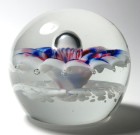 |
| 3065 | Antique Baccarat Dupont Period
Miniature Concentric Millefiori Paperweight. circa
1900-1932. This is a very nice example of a Dupont period
paperweight from Baccarat. The middle (red) ring has great
Baccarat star and arrow canes. The inner ring has nice white
stardust canes with blue whorls in the center. There is a
slight chance that this is from the classic period, but the outer
ring is less distinct which is why I think it is Dupont. The
design is off center. A very nice example. Miniature Size: Just under 2 1/16” diameter by 1
1/2” high. Base is slightly concave. Baccarat was founded in 1776 in Alsace-Lorraine with the name of Verrerie de Sainte Anne. The original location was near the town of Baccarat. Today the firm is known as Compagnie des Cristalleries de Baccarat. Most collectors refer to three periods of Baccarat paperweight production.
For extra pictures, click on the picture at the right and the following links: Large picture of the paperweight$295 postage paid in the US. Click on the picture to see a larger image. |
Click
on the picture to see a larger image 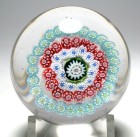 |
| 1770 | Antique German Paperweight with Picture of
Student in Fraternity Uniform. circa 1870-1915.
This is an antique paperweight with a photograph or painting of a
young man in a military type uniform. The image is on a white
enamel plaque and is either a painting or a hand colored
photograph. The enamel plaque is placed in the center of a
spatter or frit ground. An interesting and rare type of
paperweight. The paperweight was most likely made in Germany or
Silesia. A great addition to any collection of antique
European paperweights.
Note: There is a fracture surrounding the image that is caused by incompatibilities between the plaque and the surrounding glass. This type of fracture is, unfortunately, fairly common in plaque weights of that period. After considerable research, I have concluded that the uniform is probably one used by a German or Austrian university student fraternity or student association. Members of these student associations surrounded themselves with the symbols of their fraternities. The uniforms are quite commonly depicted on German steins and other "studentica" of the period. For more information, see http://stein-collectors.org/library/articles/Student/studentica.html Size: 2 1/2” diameter by 1 3/4” high. The
bottom is fire finished with remnants of the pontil mark. For extra pictures, click on the picture at the right and the following links: Large picture of the paperweightNew Price $185 (was $265) postage paid in the US. Click on the picture to see a larger image. |
Click on the picture
to see a larger image 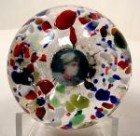 |
| 3112 | Magnum Antique Union Glass (Somerville,
Massachusetts) Paperweight "GEORGE M FLINT". Circa
1900-1929. This is a great Union Glass Company Paperweight
featuring a garland of eight lampwork flowers and the name "GEORGE M
FLINT" in the center. There are four red flowers and four blue
flowers, each with four petals, four light blue sepals, and a white
dot in the center. The letter "G" at the beginning of "GEORGE"
is reversed. In perfect condition. Union Glass Company of Somerville, Massachusetts is the third of three related factories in the Boston area. The first two were the Boston & Sandwich (B&S) Glass Company and the New England Glass Company (NEGC). Both B&S and NEGC produced paperweights at the same time, both were founded by Deming Jarvis, and both declared bankruptcy in 1888. Union Glass came a little later. It operated from 1851 to 1929. These name/date paperweights are made with lampwork flowers and letters and are not frit weights. There are some nice articles in the literature including a lengthy article in the Paperweight Collectors Association 2004 Annual Bulletin. There is also a short chapter in George Kulles' third book - Identifying Antique Paperweights - The Less Familiar. Nicholas Lutz worked at Union Glass from 1895 to 1904 and his influence can be seen on the Union Glass flowers although most of these weights were made after Lutz's death. There is some current speculation that Lutz had an apprentice who continued to work at Union Glass and was responsible for not only some of the better Union Glass examples, but also some of the fine lampwork paperweights attributed to Mount Washington Glass. Very Large Size: Just under 3 11/16" diameter by 2
5/16" high. It weighs 2 pounds 2 ounces. The
bottom is ground flat with a clear finish. For extra pictures, click on the picture at the right and the following links: Large picture$345 postage paid in the US. Click on the picture to see a larger image. |
Click on the picture
to see a larger image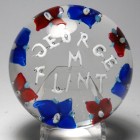 |
| 2257 | Large Antique Dorflinger Red over White
Petaled Lily-Style Paperweight. circa 1895-1920.
This lily paperweight has
four large red petals or panels, each with a red color over a
white base. The petals form a deep well in the center.
They are pleated with a large bubble and second smaller bubble
between each pleat. There is also a larger center
bubble. The petals are formed by
pushing the top of the design down with a crimp. The
paperweight is confirmed to have been made at Dorflinger
Glass. An amazing large paperweight with considerable
depth. This style of paperweight is referred to as a lily paperweight. It is similar to the pleated umbrella-style paperweights and paperweight inkwells made at Whitall Tatum in Millville, NJ (circa 1900-1912). The Millville umbrella designs usually have more pleats, typically eight, but four paneled examples also exist. The umbrella shaped weights were originally modeled to resemble the wild tiger lily of Southern New Jersey. C. Dorflinger & Sons Glass Company was founded by Christian Dorflinger in White Mills, PA in 1865. Paperweight stoppers for bottles were made by Nicholas and Francois Lutz at Dorflinger during the period 1866-1870. Lily style paperweights and other large paperweights, some with foil lettering and dates, were made by other glass workers at Dorflinger from 1895 to 1920. Recent research at the Dorflinger Glass Museum has located a catalog including references to paperweights. Most of the credit for the later styles of paperweights has been given to Tobias N. Hagberg and Ernst Von Dohln, although other Dorflinger workers also tried their hand. None of the paperweights is dated later than 1915. Christian Dorflinger died in 1915 and the business closed in 1921. Large Size : 3 5/`6” diameter by 3 3/4" high.
The base is ground flat. For extra pictures, click on the picture at the right and the following links: Large picture$395 postage paid in the US. Click on the picture to see a larger image. |
Click on the picture
to see a larger image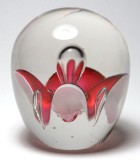 |
|
2409
|
Antique Clichy Faceted Concentric
Millefiori Paperweight with 11 roses. circa
1845-1860. This wonderful antique Clichy concentric
millefiori paperweight has a classic arrangement of three
concentric rings of complex millefiori around a blue pastry mold
cane. The inner ring has eleven green and white roses.
The second ring consists of fifteen pink pastry mold
canes. The outer ring has an alternating pattern of 24
canes with six purple pastry mold canes and 18 pink and green
canes. The 18 pink and green complex canes resemble the
color of pink and green roses. In all, there are 51
millefiori canes over a clear ground. The canes are
intricate and very colorful. See the close-up picture for
more detail. There are six side facets and a top
facet. A fantastic paperweight. Clichy paperweights are highly sought after by collectors for their complex canes and brilliant colors. Clichy paperweights with rose canes are especially desirable. The Clichy factory was founded at Billancourt near Paris in 1837. Shortly after that it moved to Clichy-la-Garenne, which gave the factory its best known name. They stayed in operation until about the 1870s. Size: 2 5/8" diameter by 1 3/4" high. The base
is ground concave. There are six side facets and a top
facet. For extra pictures, click on the picture at the right and the following links: Large pictureNew Price $645 (was $1,295) postage paid in the US. Click on the picture to see a larger image. |
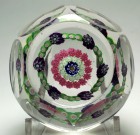 |
| 4245 | Antique Baccarat Miniature Spaced
Concentric Millefiori Paperweight with Four Gridel Canes on a Lace
Ground. circa 1847-1860. Antique Baccarat spaced
concentric millefiori paperweight with seven complex millefiori
canes, including four Gridel figures, the butterfly, dog, goat, and
deer. There are also two arrowhead canes and a multicolored
complex cane. Six canes are arranged in a circle around a
great center cane. The design is placed on a white lace ground
with bits of colored filigree. This perfectly balanced
miniature paperweight will be a wonderful to any collection antique
paperweights. According to Paul Dunlop in the Dictionary of Glass Paperweights, the first Gridel cane to appear was the lovebirds cane, which appeared in some 1846 paperweights. The others appeared in 1847 or later. Baccarat was founded in 1776 in Alsace-Lorraine with the name of Verrerie de Sainte Anne. The original location was near the town of Baccarat. Today the firm is known as Compagnie des Cristalleries de Baccarat. Most collectors refer to three periods of Baccarat paperweight production.
Baccarat continued to make paperweights after the classic period (1845-1860), but little is known about the extent of the product line or who made the paperweights. It is known that by 1910, the offering in the catalog had dwindled to pansy paperweights, simple open concentric paperweights, and rock paperweights. Popular lore attributes 1920-1934 Baccarat paperweights to a Mr. Dupont, who supposedly was the last worker at Baccarat to know the secrets of paperweight making. These paperweights were sold at a Baccarat retail shop in Paris. No collector or scholar ever met Mr. Dupont although at least one visited the Baccarat factory and asked to meet with him. The weights stopped appearing in the shop in 1934. New research of the Baccarat archives has identified the actual maker as Joseph Boyé (1877-1948). He is recorded as the maker of millefiori canes and millefiori paperweights during this period (1920-1934). Very little is known about Mr. Boyé, but there is enough similarity in the millefiori canes to suggest that he had access to the original molds or some of the original millefiori canes from the classic period. He later trained another glassworker, Georges Brocard, to make open concentric paperweights in 1946. Armed with this knowledge, Brocard was influential in the revival of paperweight making at Baccarat in the 1950s. Another glassworker, Louis Idoux (1882-1941), is recorded as making the Baccarat pansy paperweights during the 1920-1934 period. You can read more about the Baccarat paperweights in the book Baccarat Paperweights - two centuries of beauty by Paul Dunlop or one of the older books on paperweights in general, such as The Encyclopedia of Glass Paperweights by Paul Hollister or World Paperweights by Robert Hall. Miniature Size: Just under 2" diameter by 1 3/8"
high. The bottom is ground concave.. For extra pictures, click on the picture at the right and the following links: Large picture of the paperweightSOLD. US sales only for this paperweight. Delivery will require a signature. Click on the picture to see a larger image. |
Click
on the picture to see a larger image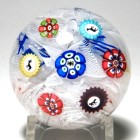 |
| 4199 | Large Antique Baccarat Double Trefoil
Millefiori Paperweight. circa 1845-1860. Colorful
antique Baccarat double trefoil millefiori paperweight with a clear
ground. The trefoils are constructed with blue and white
canes. In the center is a circle of green and white canes with
a orange cane in the very center. I believe this is from the
classic period of paperweight production (1845-1860), but it may
date from a later period. An interesting example. Note on colors: Please ignore the brown colors in some of the pictures. They are reflections from something in my work area. The glass is clear. Baccarat was founded in 1776 in Alsace-Lorraine with the name of Verrerie de Sainte Anne. The original location was near the town of Baccarat. Today the firm is known as Compagnie des Cristalleries de Baccarat. Most collectors refer to three periods of Baccarat paperweight production.
Large size: Just over 2 3/4" diameter by 1 7/8"
high. The bottom is polished concave. Unusually
high dome with the original Baccarat profile. For extra pictures, click on the picture at the right and the following links: Large pictureSOLD. Click on the picture to see a larger image. |
Click
on the picture to see a larger image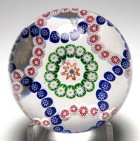 |
| 2958 | Antique Baccarat Roundels or Circlets
Millefiori Paperweight. circa 1845-1860. Antique
Baccarat millefiori paperweight with a red, white, and blue garland
pattern consisting of seven circles of millefiori canes, each with a
single complex cane in the center. Six of the roundels are
arranged in a a circle around the center roundel. The design
is placed over a clear ground. The paperweight is unsigned but
has several unique Baccarat canes and I guarantee that this is a
genuine Baccarat millefiori paperweight from the classic period
1845-1860. A desirable addition to any collection of antique
paperweights. Great color. Baccarat was founded in 1776 in Alsace-Lorraine with the name of Verrerie de Sainte Anne. The original location was near the town of Baccarat. Today the firm is known as Compagnie des Cristalleries de Baccarat. Most collectors refer to three periods of Baccarat paperweight production.
In 1952, Paul Jokelson approached Baccarat
with the idea of making sulphide paperweights again. In
1953 Baccarat resumed paperweight production with a series of
sulphide paperweights the first of which were the unsuccessful
Eisenhower sulphide followed by the Queen Elizabeth coronation
sulphide. Millefiori paperweight production was resumed in
1957 and lampwork paperweights were re-introduced in the early
1970s. Baccarat stopped making this type of fine glass
paperweights in 2002. You can read more about the Baccarat
paperweights in the book Baccarat
Paperweights - two centuries of beauty by
Paul Dunlop or one of the older books on paperweights in
general, such as The
Encyclopedia of Glass Paperweights by Paul Hollister
or World Paperweights by Robert
Hall. Size: 2 5/8" diameter by 1 3/4" high. The
bottom is ground concave. For extra pictures, click on the picture at the right and the following links: Large pictureSOLD. Click on the picture to see a larger image. |
Click
on the picture to see a larger image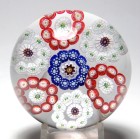 |
| 2398 | Antique Magnum Millville Masonic Frit
Paperweight. circa 1880-1920. This
antique frit paperweight features a Mason's square and compass
symbol with a "G" in the center. It was made in Millville, New
Jersey around the end of the 19th century. Blue and red ground
glass (frit) was used to make the design on a white ground.
The glass has a slightly green tint that is exaggerated in the
pictures. The profile is relatively flat. The
paperweight was made for the Masons, a fraternal organization,
probably at the Whitall Tatum factory in Millville, New Jersey. Frit refers to the powdered glass used to make the design. The design is set up in frit in a metal die and then picked up with a gather of the ground color. When encased, there is sometimes a ridge or crease line between the solid (in this case white) base area and the clear encasement. Collectors refer to this as two piece construction. This type of construction has been associated with Whitall Tatum and other factories in the Millville area. There is no crease on this paperweight, but the encasement stops where the white ground color starts. Note: Sometimes this style of paperweight will have an clear circle in the center of the base where the pontil would have been attached. Because a number of weights of this type (with the clear circle on the base) have been found in the Corning area, some collectors conjectured that the paperweights with a clear circle on the base were made in the Corning, NY area rather than Millville, NJ. I reject that conjecture as I have had this exact design with and without the clear circle. I believe both types were made in Millville and the difference is how much glass is removed when grinding the base to remove the pontil scar. Whitall Tatum was one of the first glass factories in America. Located in Millville, New Jersey, it was in operation from 1806 through 1938. The factory in Millville was purchased by a series of companies and eventually shut down in 1999. It is believed that Whitall Tatum workers were allowed to make paperweights from as early as 1860 until the practice was discouraged sometime after 1912. According to Newell's Old Glass Paperweights of Southern New Jersey , frit weights were made as early as 1863. Newell identifies this style as a true American folk art and gives a history of paperweight making at Whitall Tatum and other South Jersey factories. Very large size: Just over 3 1/4" diameter by 1 7/8"
high. The profile is relatively flat. The base is
ground flat. For extra pictures, click on the picture at the right and the following links: Large picture$145 postage paid in the US.
Click on the picture to see a larger image. |
Click
on the picture to see a larger image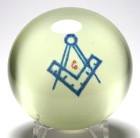 |
| 5283 | Antique Clichy Spaced Concentric
Millefiori on Lace Paperweight with Rose. circa
1845-1860. This antique Clichy spaced concentric millefiori
paperweight has a two concentric rings of complex millefiori around
a central red pastry mold cane. There is a wonderful large
green and pink Clichy rose in the inner ring. There are 19
canes in all, all placed on an upset muslin or lace ground.
The canes are intricate and very colorful. See the close-up
picture for more detail. A especially nice antique Clichy
paperweight.
Clichy paperweights are highly sought after by collectors for their complex canes and brilliant colors. Clichy paperweights with rose canes are especially desirable. The Clichy factory was founded at Billancourt near Paris in 1837. Shortly after that it moved to Clichy-la-Garenne, which gave the factory its best known name. They stayed in operation until about the 1870s. Small Size: 2 1/4" diameter by just over 1 5/8"
high. The base is ground slightly concave. For extra pictures, click on the picture at the right and the following links: Large pictureSOLD. US Sales only, no international shipping. Delivery will require a signature.
Click on the picture to see a larger image. |
Click
on the picture to see a larger image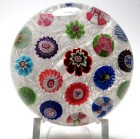 |
| 2528 | Antique Belgian or Bohemian Doorknob with
Miniature Concentric Millefiori Paperweight Handle. circa
1880-1910. This is a wonderful antique doorknob with a
concentric millefiori paperweight handle. The handle has
bright colors on a clear ground. It has two concentric circles
of canes around a complex center cane. The outer ring
alternates between larger complex blue and white canes and simpler
red and white canes. One red cane is missing. The inner
ring consists of six large identical white, pink, and yellow complex
canes. There is a complex green, pink, and yellow center
cane. The maker of this paperweight is unknown. It has
similarities to a group of paperweights believed to have originated
at an unidentified glass factory in Belgium, Northern Europe, or
even Bohemia. The hardware portion is in good condition with a
fixed spindle. The design is well centered and a wonder to
study. This paperweight has a strong similarity to a group of paperweights and doorknobs that are believed to have originated at an unidentified glass factory in Belgium or Northern Europe. Bohemian Glass generally refers to the glass made in the regions that form the border area between the Czech Republic, Poland, and Germany. Most of these areas are now parts of the western Czech Republic. Size: The knob is 1 13/16" diameter by 2 3/16" long
including the brass hardware, but not the spindle. With the
spindle, it is 4 13/16" long. For extra pictures, click on the picture at the right and the following links: Large pictureSOLD. Click on the picture to see a larger image. |
Click
on the picture to see a larger image 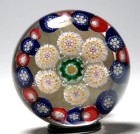 |
| 1297 | Antique Green and White Jasper Ground
Paperweight. circa 1845-1890. This is
an unusual antique jasper ground paperweight - unusual in that there
is no other motif present. Normally we find a jasper ground
paperweight with a flower or a millefiori pattern. It could be
a practice piece made by a glass worker learning how to create a
jasper ground, or it could be that the flower or design wasn't ready
when it needed to be picked up. I don't know which factory
made it. Among antique American paperweight makers, both the
New England Glass Company and the Boston and Sandwich Glass Company
made floral paperweights with jasper grounds. In France, St.
Louis made jasper ground paperweights during the classic period
(1845 - 1860). Other factories probably did as well. So
the origin remains a mystery, but I think it is likely to have been
made at the New England Glass Company (NEGC). A colorful
example that you will keep on your desk and use as - a paperweight. Large Size: 2 3/4" diameter by 1 3/4" high. The base
is ground concave with a pontil scar remaining. For extra pictures, click on the picture at the right and the following links: Large picture$85 postage paid in the US. Click on the picture to see a larger image. |
Click
on the picture to see a larger image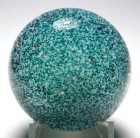 |
| 5341 | Antique Sulphide of Young Napoléon
Bonaparte - Probably Clichy. circa 1848-1852.
Napoleon III (Charles-Louis Napoléon Bonaparte; April 20, 1808 to
January 9, 1873) was the first president of France from 1848 to
1852, and the last monarch of France as Emperor of the French from
1852 until he was deposed in absentia on September 4, 1870.
This paperweight features an image of a younger Napoléon Bonaparte
as he wore his facial hair around the time he was elected President
of France at the age of 40. Unfortunately the appearance of
the paperweight is marred by a bubble in front of the tip of his
nose. This would be a good addition to a collection of
sulphide paperweights or a collection of French historical objects. Sulphides are cast objects (animals,
flowers, people) made of a ceramic material that has properties
similar to the surrounding glass. They are normally white,
but are also sometimes colored or even painted. The
objects are cast in a mold that copied or made directly from a
medallion, coin or sculpture. The finest French sulphides
are cast in a mold made by a skilled artist. Often a
sulphide will have a silvery appearance due to a thin layer of
trapped bubbles between the glass and the sulphide itself.
Antique sulphide paperweights are fairly rare and many are
believed to have been made by Clichy. Clichy paperweights are highly
sought after by collectors for their complex canes and brilliant
colors. Clichy paperweights with rose canes are especially
desirable. The Clichy factory was founded at Billancourt
near Paris in 1837. Shortly after that it moved to
Clichy-la-Garenne, which gave the factory its best known
name. They stayed in operation until about the
1870s. Size: Just under 2 5/8” diameter by 1 13/16” high.
The base is ground concave. For extra pictures, click on the picture at the right and the following links: Large pictureSOLD. Click on the picture to see a larger image. |
Click
on the picture to see a larger image 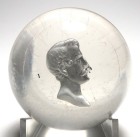 |
| 885 | Antique Abraham Lincoln Pressed Glass
Intaglio Paperweight. circa 1883 and later. This
pressed glass paperweight features a frosted profile of Lincoln with
very good detail. It has a curved top and flat base. The
image is intaglio or incised from the base and is finished with an
acid etching (frosted finish). There is a slight red tint to
the glass. The maker has been identified by various sources as
Libbey or Gillinder. It is possible first introduced as a
souvenir paperweight offered at the 1893 Columbian Exposition in
Chicago. Please see the note below about a chip on the base
and review the pictures.
Note on condition: This paperweight has a 3/8"
shallow chip on a corner of the back side as shown in the
pictures. It displays well in spite of the damage and could
be restored if desired. Size: Just under 4 1/2" tall by just under 3" wide
by 7/8" thick. For extra pictures, click on the picture at the right and the following links: Large picture$39 postage paid in the US. Click on the picture to see a larger image. |
Click
on the picture to see a larger image |
Revised 9/9/2024 IE9